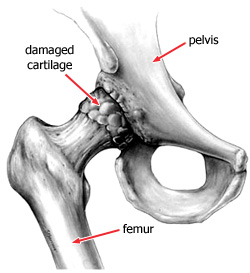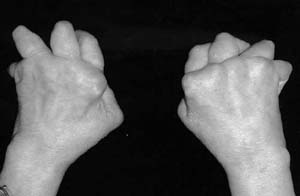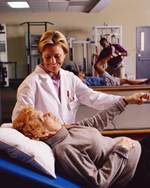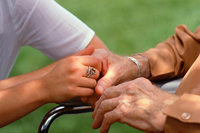Arthritis literally means “inflammation of a joint.” In some forms of arthritis, such as osteoarthritis, the inflammation arises because the smooth covering (articular cartilage) on the ends of bones become damaged or worn. Osteoarthritis is usually found in one, usually weightbearing, joint.
In other forms of arthritis, such as rheumatoid arthritis, the joint lining becomes inflamed as part of a disease process that affects the entire body. Some other types of arthritis are: seronegative spondyloarthropathies, crytalline deposition diseases, and septic arthritis.
Arthritis is a major cause of lost work time and serious disability for many people. Although arthritis is mainly a disease of adults, children may also have it.
Anatomy
Arthritis is a disease of the joint. A joint is where the ends of two or more bones meet. The knee joint, for example, is formed between the bones of the lower leg (the tibia and the fibula) and the thighbone (the femur). The hip joint is where the top of the thighbone (femoral head) meets a concave portion of the pelvis (the acetabulum).
A smooth tissue of cartilage covers the ends of bones in a joint. Cartilage cushions the bone and allows the joint to move easily without the friction that would come with bone-on-bone contact. A joint is enclosed by a fibrous envelope, called the synovium, which produces a fluid that also helps to reduce friction and wear in a joint. Ligaments connect the bones and keep the joint stable. Muscles and tendons power the joint and enable it to move.
Cause
There are two major categories of arthritis.

The first type is caused by wear and tear on the articular cartilage (osteoarthritis) through the natural aging process, through constant use, or through trauma (post-traumatic arthritis).
The second type is caused by one of a number of inflammatory processes.
Regardless of whether the cause is from injury, normal wear and tear, or disease, the joint becomes inflamed, causing swelling, pain and stiffness. This is usually temporary. Inflammation is one of the body’s normal reactions to injury or disease.
In arthritic joints, however, inflammation may cause long-lasting or permanent disability.
Natural History
Osteoarthritis

The most common type of arthritis is osteoarthritis. It results from overuse, trauma, or the degeneration of the joint cartilage that takes place with age. Osteoarthritis is often more painful in joints that bear weight, such as the knee, hip, and spine, rather than in the wrist, elbow, and shoulder joints. However, joints that are used extensively in work or sports or joints that have been damaged from fractures or other injuries may show signs of osteoarthritis. Other disorders that injure or overload the articular cartilage may lead to osteoarthritis.
In osteoarthritis, the cartilage covering the bone ends gradually wears away. In many cases, bone growths called “spurs” develop at the edges of osteoarthritic joints. The bone can become hard and firm (sclerosis). The joint becomes inflamed, causing pain and swelling. Continued use of the joint
Rheumatoid Arthritis

Rheumatoid arthritis is a long-lasting disease. It is estimated that 1% of the population throughout the world have rheumatoid arthritis. Women are three times more likely than men to have rheumatoid arthritis. The development of rheumatoid arthritis slows with age.
Rheumatoid arthritis affects many parts of the body, but mainly the joints. The body’s immune system, which normally protects the body, begins to produce substances that attack the body. In rheumatoid arthritis, the joint lining swells, invading surrounding tissues. Chemical substances are produced that attack and destroy the joint surface.
Rheumatoid arthritis may affect both large and small joints in the body and also the spine. Swelling, pain, and stiffness usually develop, even when the joint is not used. In some circumstances, juvenile arthritis may cause similar symptoms in children.
Diagnosis
Arthritis is diagnosed through a careful evaluation of symptoms and a physical examination. X-rays are important to show the extent of any damage to the joint. Blood tests and other laboratory tests may help to determine the type of arthritis. Some of the findings of arthritis include:
- Weakness (atrophy) in the muscles
- Tenderness to touch
- Limited ability to move the joint passively (with assistance) and actively (without assistance).
- Signs that other joints are painful or swollen (an indication of rheumatoid arthritis)
- A grating feeling or sound (crepitus) with movement
- Pain when pressure is placed on the joint or the joint is moved
Medications
Over-the-counter medications can be used to control pain and inflammation in the joints. These medications, called anti-inflammatory drugs, include aspirin, ibuprofen, and naproxen. Acetaminophen can be effective in controlling pain.
Prescription medications also are available. A physician will choose a medication by taking into account the type of arthritis, its severity, and the patient’s general physical health. Patients with ulcers, asthma, kidney, or liver disease, for example, may not be able to safely take anti-inflammatory medications.
Injections of cortisone into the joint may temporarily help to relieve pain and swelling. It is important to know that repeated, frequent injections into the same joint can damage it, causing undesirable side effects.
Viscosupplementation or injection of hyaluronic acid preparations can also be helpful in lubricating the joint. This is typically perfomed in the knee.
Exercise and Therapy

Canes, crutches, walkers, or splints may help relieve the stress and strain on arthritic joints. Learning methods of performing daily activities that are the less stressful to painful joints also may be helpful.
Certain exercises and physical therapy may be used to decrease stiffness and to strengthen the weakened muscles around the joint.
Surgery
In general, an orthopaedic surgeon will perform surgery for arthritis when other methods of nonsurgical treatment have failed to relieve pain and other symptoms. When deciding on the type of surgery, the physician and patient will take into account the type of arthritis, its severity, and the patient’s physical condition.
There are a number of surgical procedures. These include:
- Removing the diseased or damaged joint lining
- Realignment of the joints
- Fusing the ends of the bones in the joint together, to prevent joint motion and relieve joint pain
- Replacing the entire joint (total joint replacement)
Long-Term Management

In most cases, persons with arthritis can continue to perform normal activities of daily living. Exercise programs, anti-inflammatory drugs, and weight reduction for obese persons are common measures to reduce pain, stiffness, and improve function.
In persons with severe cases of arthritis, orthopaedic surgery can often provide dramatic pain relief and restore lost joint function.
Some types of arthritis, such as rheumatoid arthritis, are often treated by a team of health care professionals. These professionals may include rheumatologists, physical and occupational therapists, social workers, rehabilitation specialists, and orthopaedic surgeons.
Research
At present, most types of arthritis cannot be cured. Researchers continue to make progress in finding the underlying causes for the major types of arthritis. In the meantime, orthopaedic surgeons, working with other physicians and scientists, have developed many effective treatments for arthritis.
